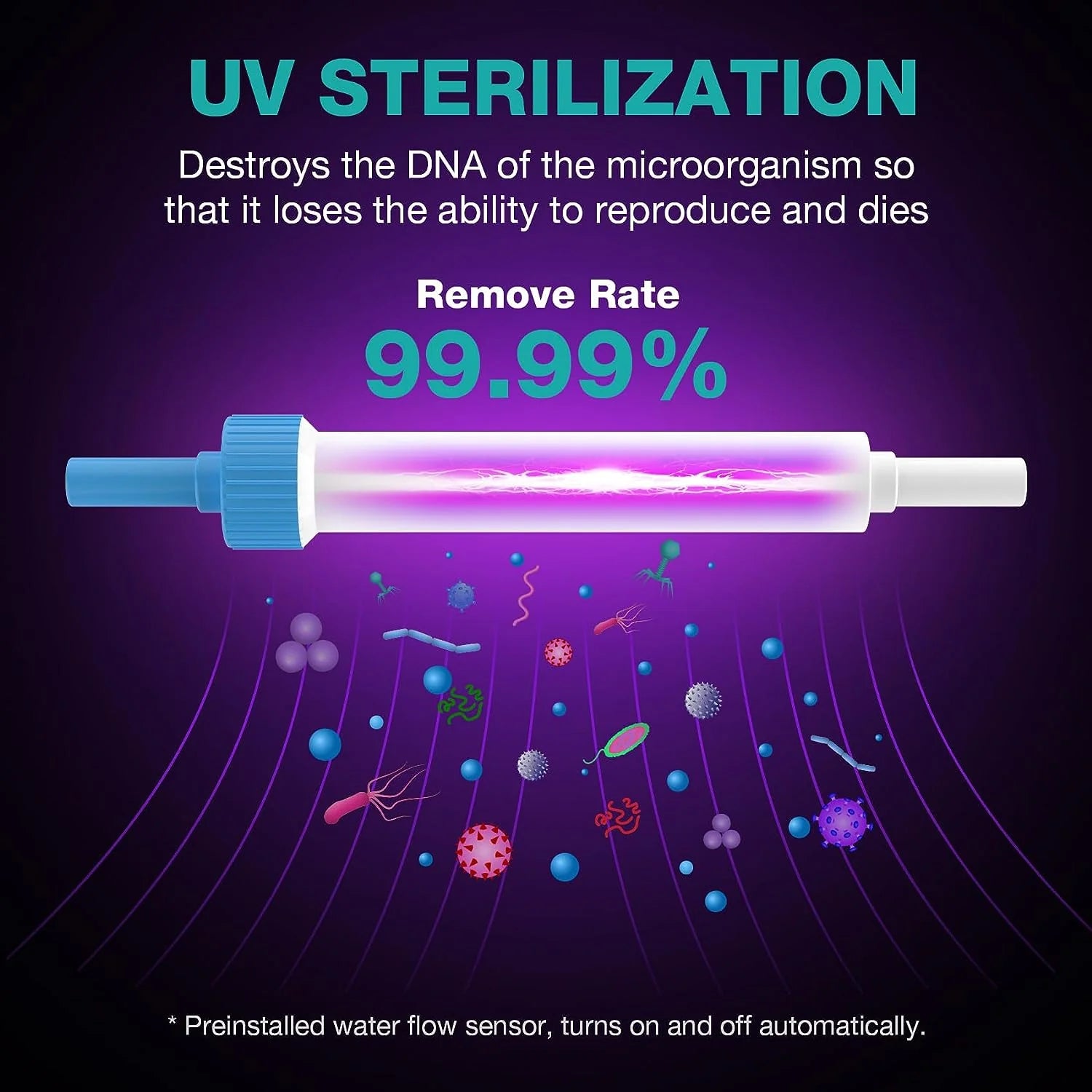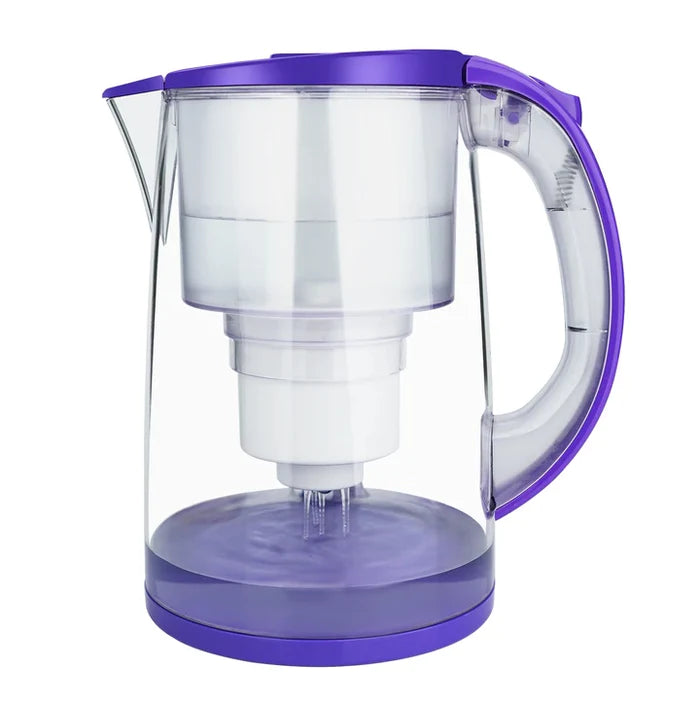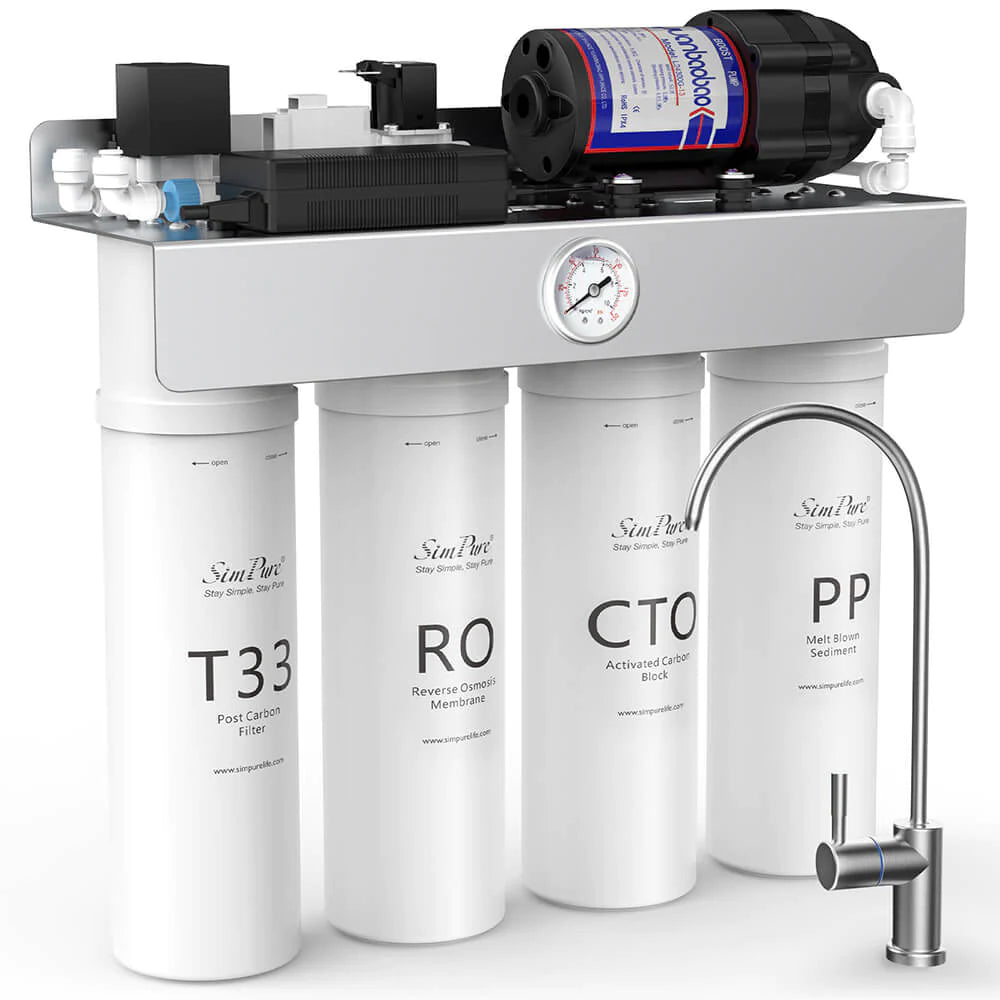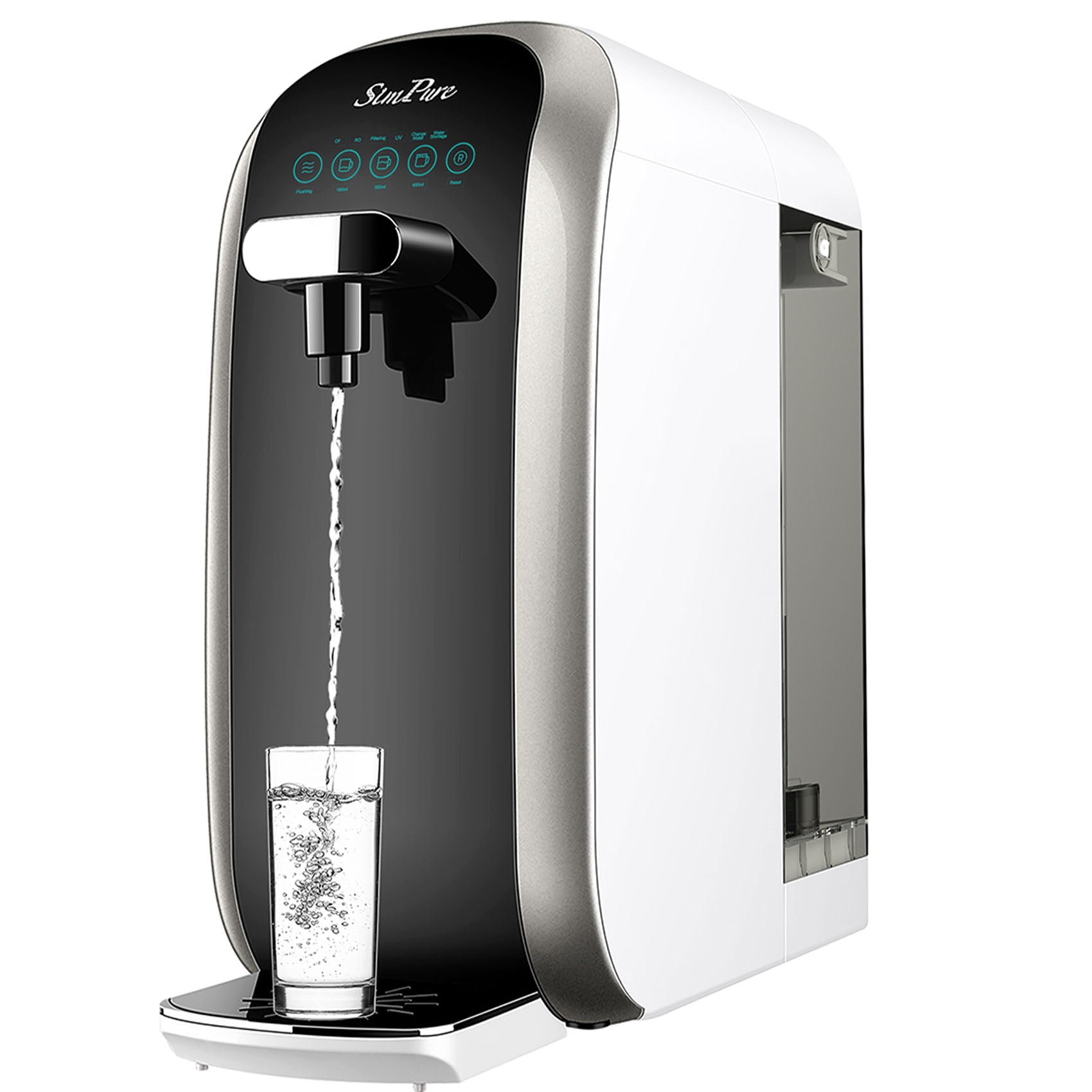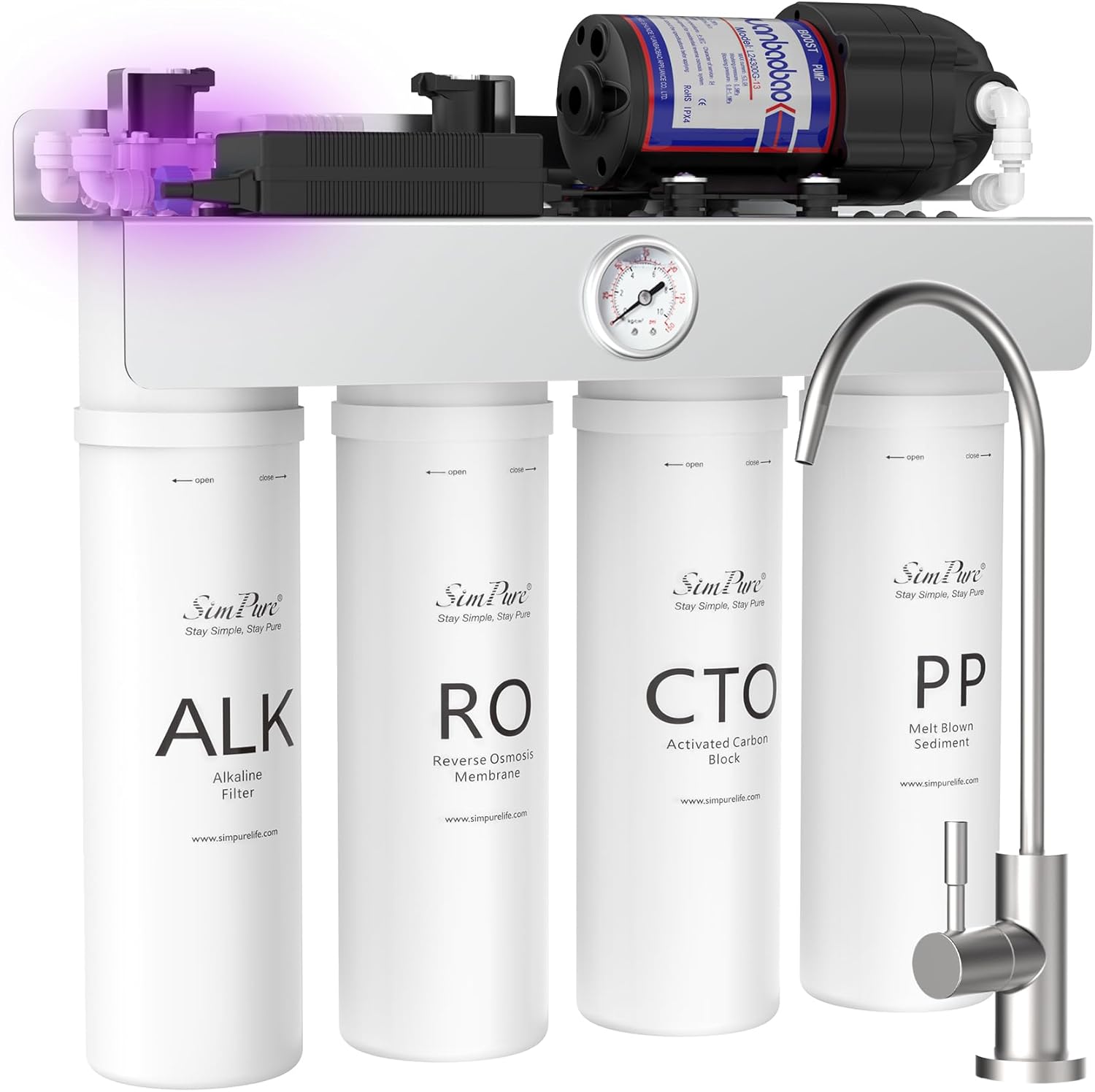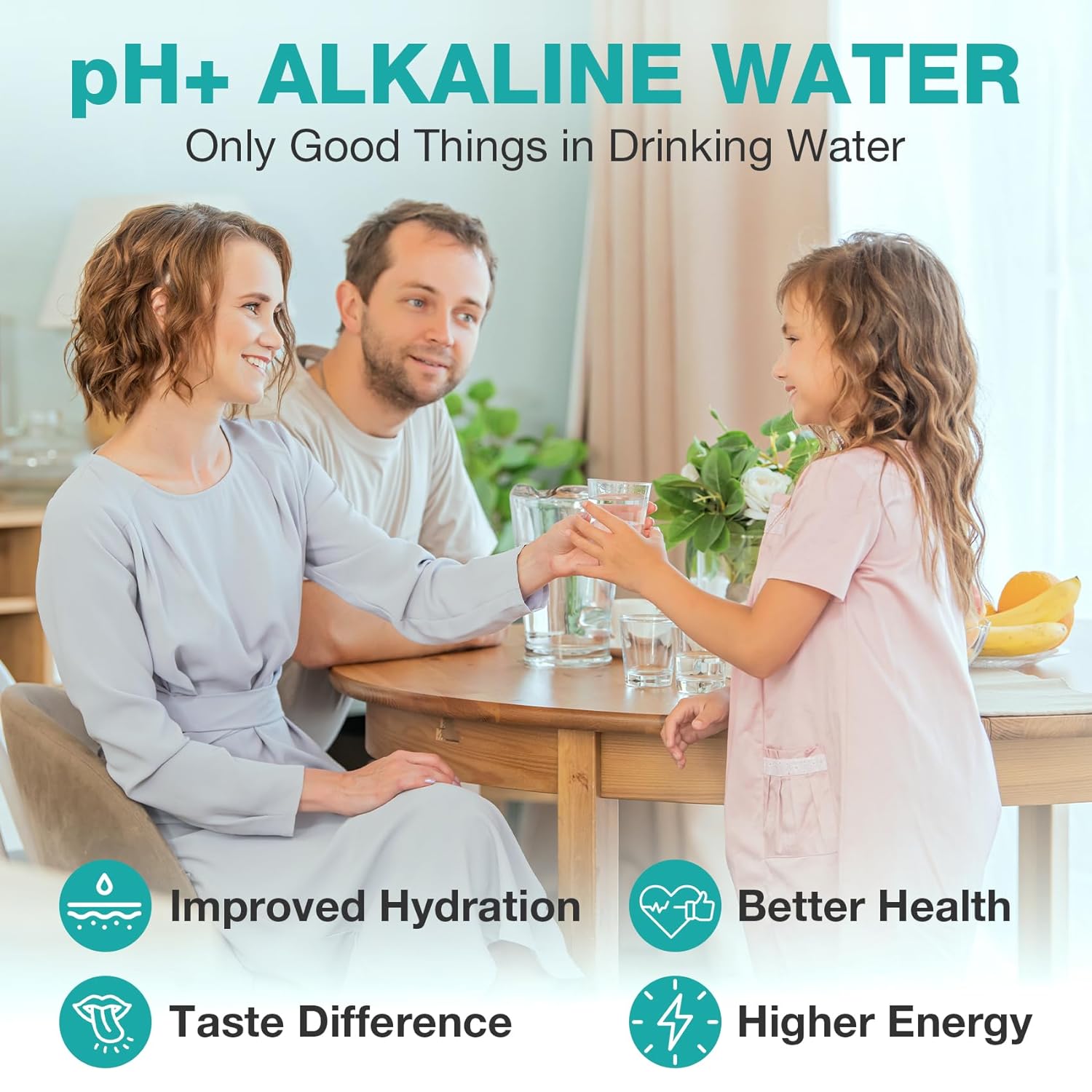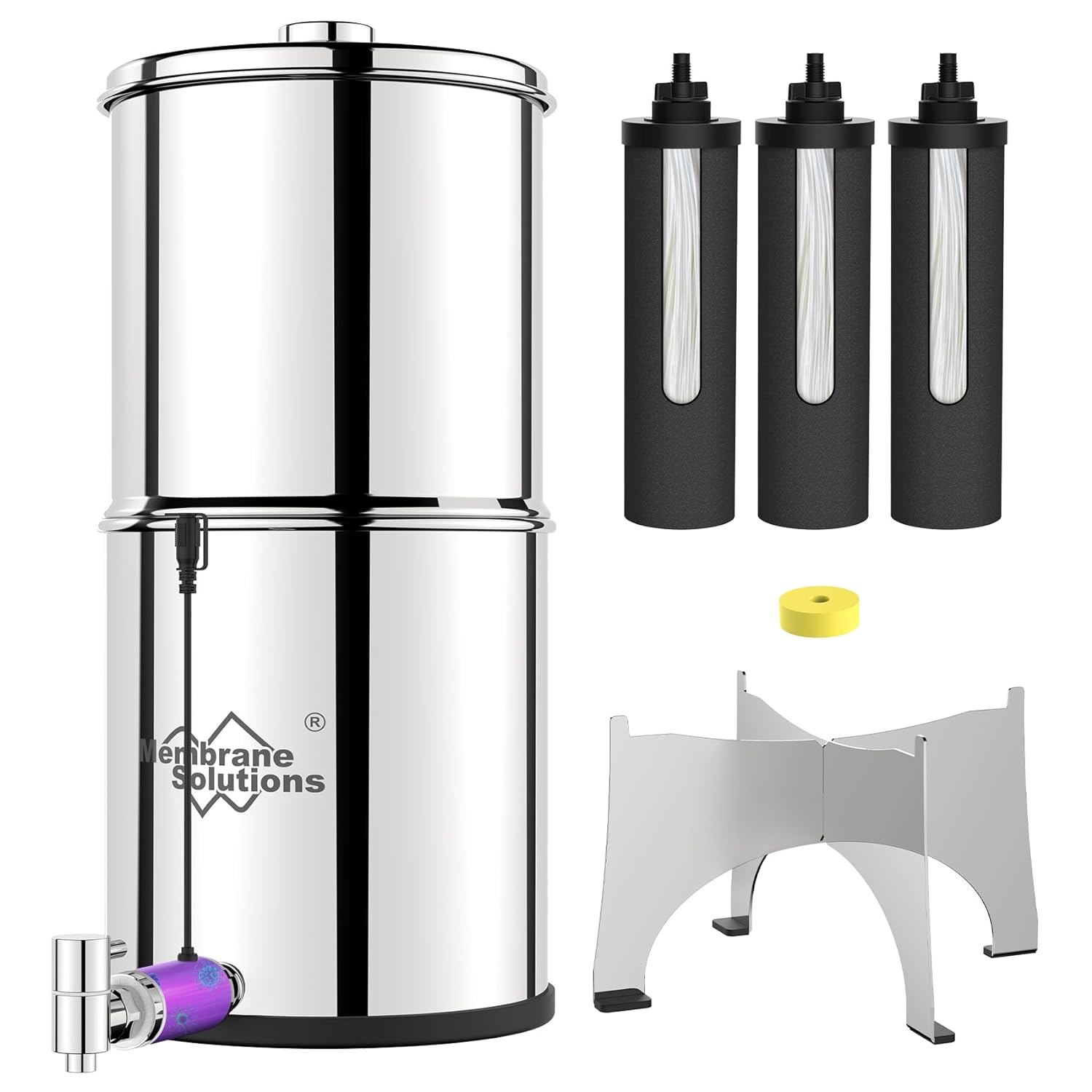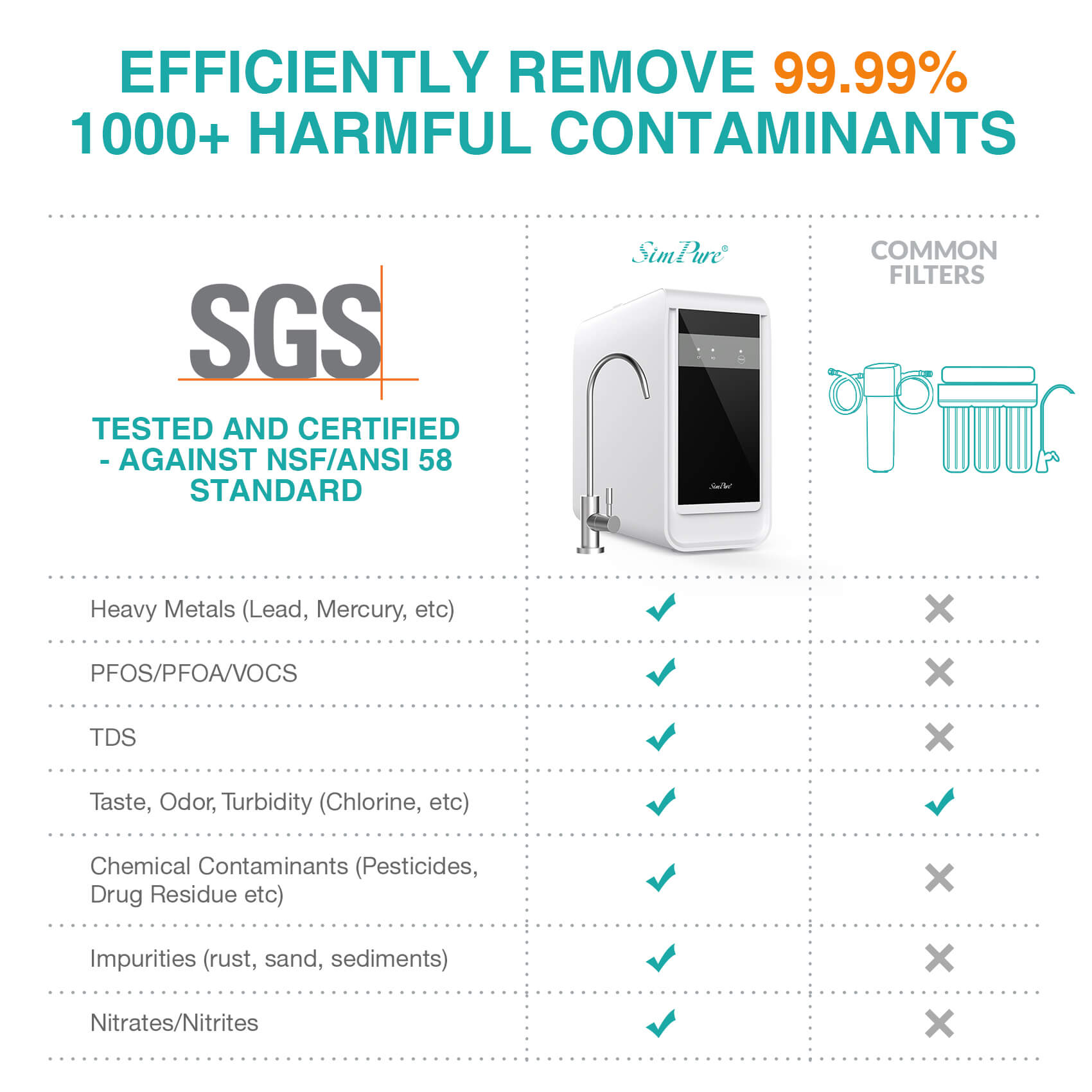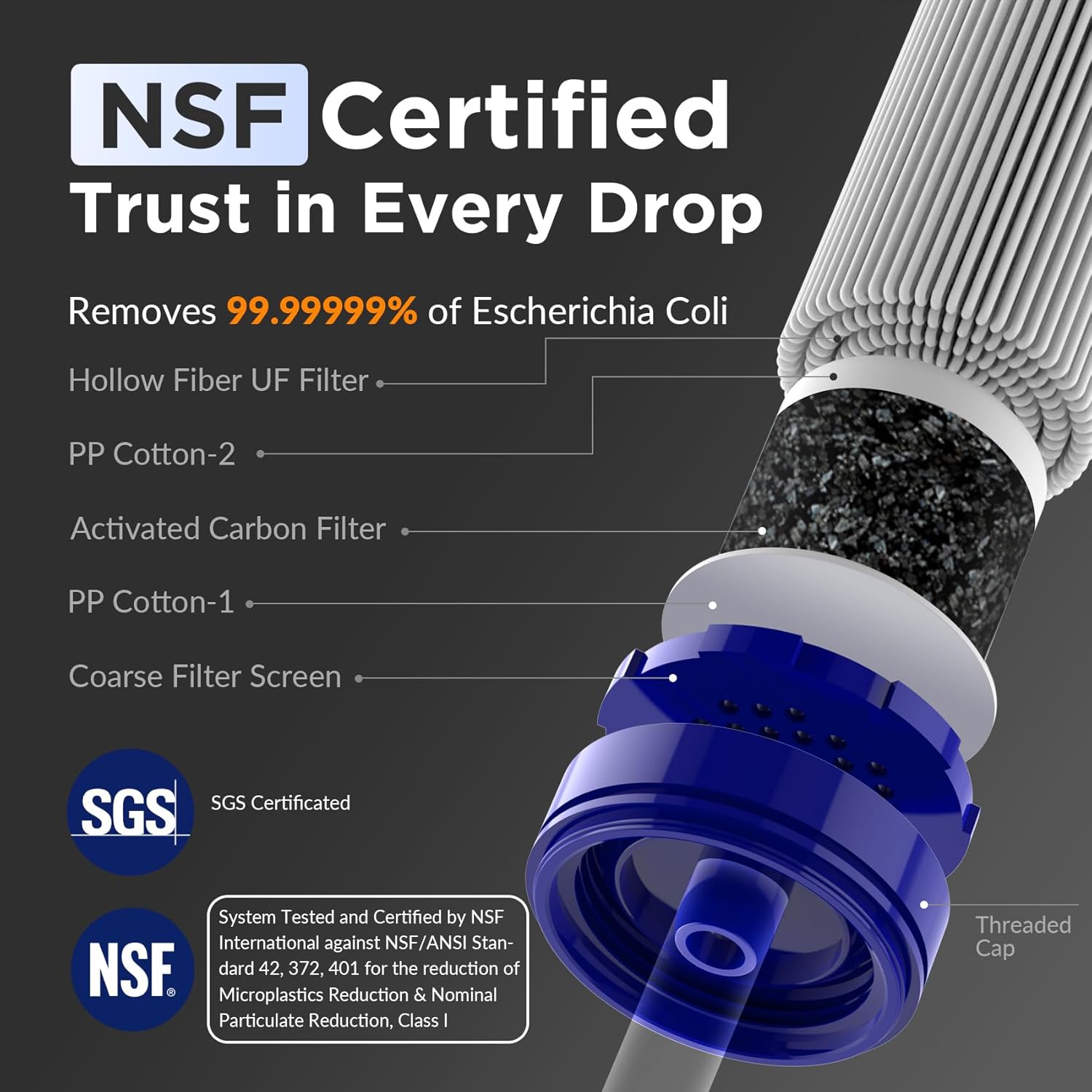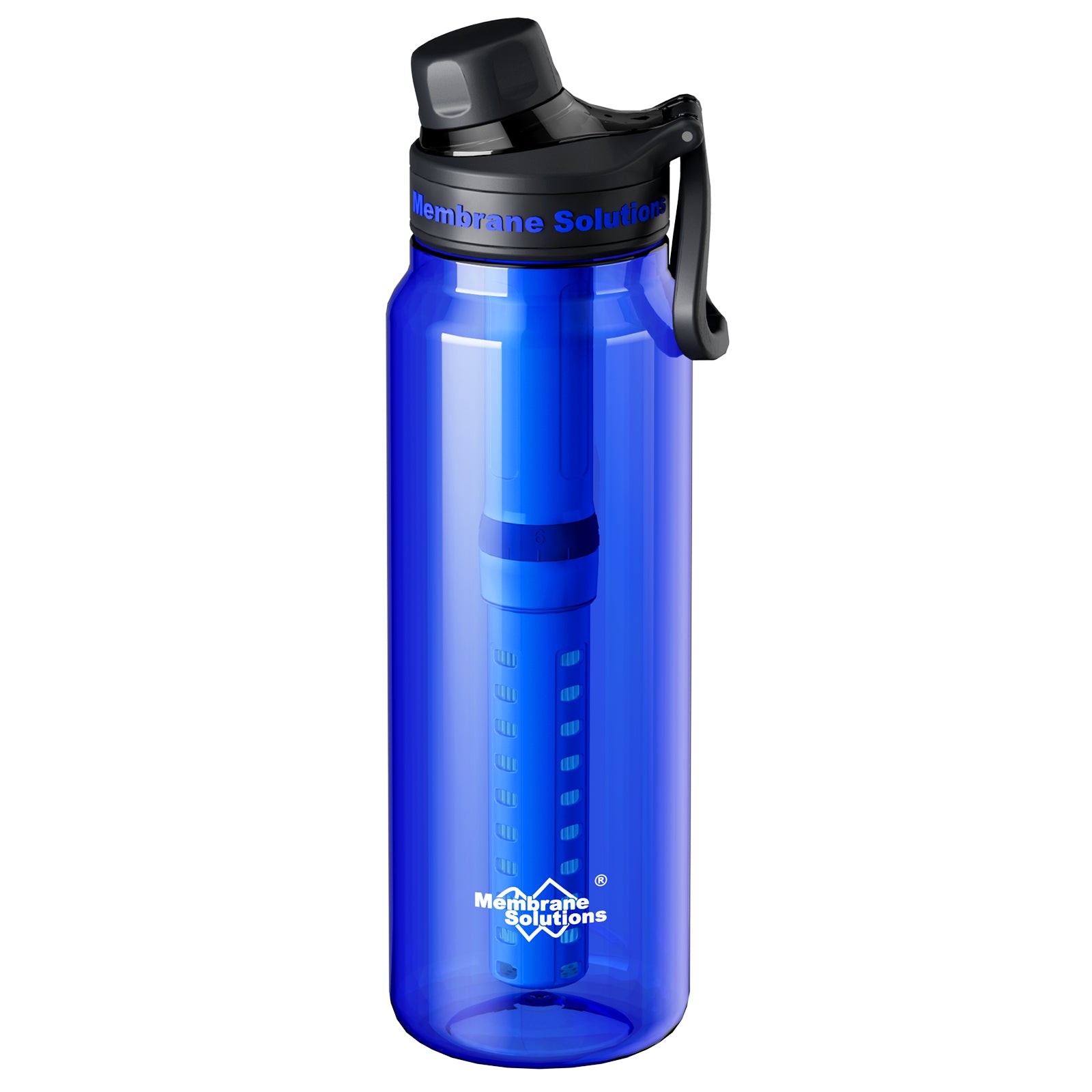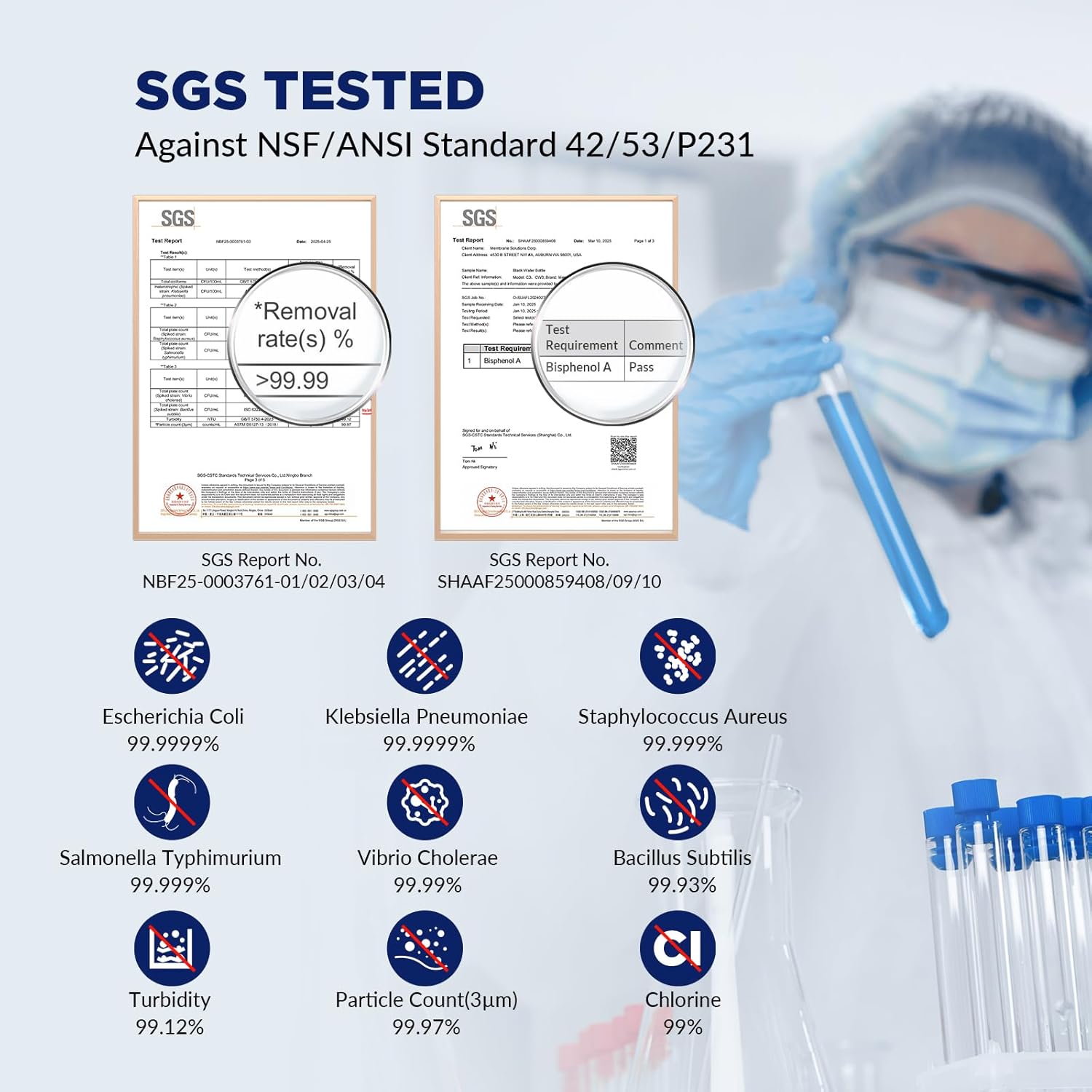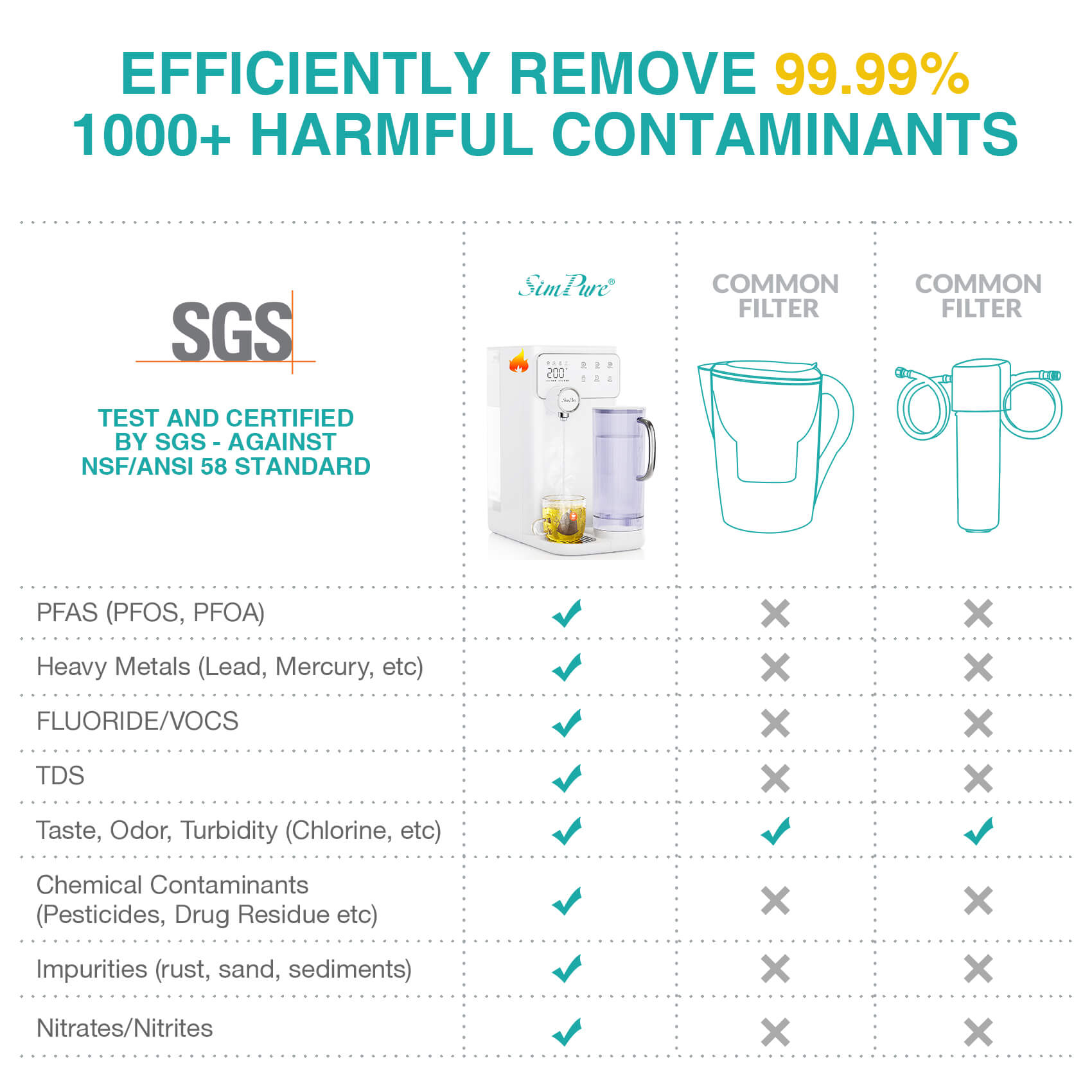Concerned about the quality of your drinking water? With contaminants like pesticides, heavy metals, and microorganisms frequently detected in US water sources, ensuring purity is of great importance. So what are some methods to purify water and eliminate these harmful substances? In this comprehensive guide, we'll explore proven methods, both free and paid, to help you make informed choices and enjoy clean, safe drinking water.
Table of Contents
2. Solar disinfection (SODIS).
4. Chlorination with household bleach.
Paid Methods to Purify Water (Low to High Cost)
Free Methods to Purify Water
For those looking to purify water without breaking the bank, we've curated a list of free methods that are both efficient and easy to use. Let's explore these budget-friendly options together and discover how they can ensure clean drinking water.
1. Boiling Water.

Boiling water is one of the oldest and most straightforward methods of purifying water. By bringing water to a rolling boil for at least one minute (or longer at higher altitudes), harmful pathogens such as bacteria, viruses, and protozoa are effectively killed, making the water safe to drink.
Process: Bring water to a vigorous boil and maintain for at least one minute.
Effectiveness: Kills most common pathogens found in water.
Pros
- Simple and easy to implement.
- Doesn't require specialized equipment.
- Effective against a wide range of contaminants.
Cons
- Doesn't remove chemical pollutants or heavy metals.
- Energy-intensive, especially for large quantities of water.
- Time-consuming, especially at higher altitudes.
- Doesn't improve taste or odor of water.
- May not be practical in emergency situations with limited fuel or resources.
Suitable People and Water Quality:
- Ideal for camping, hiking, and emergency preparedness.
- Suitable for treating clear water from known safe sources.
- Not recommended for highly contaminated or turbid water.
Recommended Reading
Does Boiling Water Remove Chlorine?
Does Boiling Water Remove Fluoride?
Does Boiling Water Remove Lead?
2. Solar disinfection (SODIS).

Solar Disinfection (SODIS) is a simple and eco-friendly technique used to purify water using sunlight. SODIS involves filling transparent bottles with water and exposing them to sunlight for several hours. Ultraviolet (UV) rays from the sun kill bacteria, viruses, and parasites present in the water, making it safe to drink.
Pros:- Cost-effective: Requires minimal equipment, making it affordable for low-income households.
- Environmentally friendly: No chemicals or energy consumption involved, reducing environmental impact.
- Easy implementation: Can be done by anyone with access to sunlight and transparent bottles.
Cons:
- Time-consuming: Requires several hours of sunlight exposure for effective disinfection.
- Weather-dependent: Effectiveness can be reduced on cloudy or rainy days.
- Limited capacity: Suitable for small quantities of water, not ideal for large-scale purification needs.
- SODIS may not remove chemical contaminants or turbidity (cloudiness) from water. It's most effective against microbial pathogens but may not address other water quality issues.
Suitability:
- Individuals or families with limited access to clean water sources.
- Outdoor enthusiasts, travelers, or campers needing to purify water on the go.
- Communities in developing regions where infrastructure for water treatment is lacking
3. Filtering with cloth.

Filtering water with cloth is a basic yet effective method used to remove visible impurities and some microbes from water. This method involves passing water through a clean cloth or fabric to strain out contaminants, making it suitable for improving water clarity and reducing turbidity.
Pros:
- Easy and inexpensive method
- Removes visible particles and sediment
- Improves water appearance and taste
Cons:
- Limited effectiveness against microscopic contaminants
- Requires clean and suitable fabric
- May not eliminate harmful bacteria or viruses
Limitations:
While filtering with cloth can improve water quality by removing visible impurities, it has limitations in purifying water from harmful microorganisms. It's essential to note that this method is more suitable for improving water clarity rather than ensuring complete microbial safety.
Suitable People:
- Individuals in emergency situations with limited access to clean water
- Those looking for a temporary solution for improving water clarity
Water Quality:
- Suitable for water with visible impurities such as sediment and debris
- Not recommended for water contaminated with pathogens or chemicals
4. Chlorination with household bleach.
Chlorination with household bleach is a simple and cost-effective way to disinfect water, which is a widely used method to purify water, especially in emergency situations or areas with limited access to clean water sources. This method involves adding a specific amount of chlorine bleach to water to kill harmful pathogens and make it safe for drinking.
Pros:
- Accessibility: Bleach is readily available in most households and emergency kits.
- Cost-effective: It's an affordable method compared to some other water purification techniques.
- Effectiveness: Chlorine effectively kills a wide range of pathogens, ensuring water safety.
- Easy to use: The process of adding bleach to water is straightforward and doesn't require specialized equipment.
Cons:
- Taste and odor: Chlorinated water may have a slight taste and odor, which some people find unpleasant.
- Residual chlorine: If not properly measured, residual chlorine levels can be too high, leading to health concerns.
- Limited effectiveness: While effective against many pathogens, chlorination may not eliminate certain contaminants like heavy metals or chemicals.
Suitability:
- Emergency situations: Chlorination with household bleach is ideal during emergencies or natural disasters when access to clean water is limited.
- Low-resource settings: It's suitable for communities or individuals with limited resources or infrastructure for water purification.
- Temporary use: Chlorination can be a temporary solution until more advanced water treatment options are available.
Recommended Reading
How to Test Chlorine in Water at Home?
How to DeChlorinate From Tap Water?
How to Remove Chlorine From Water?
What Filter Removes Chlorine From Water?
Paid Methods to Purify Water (Low to High Cost)
For those with a sufficient budget and a strong emphasis on water quality and health, paid water purification methods provide advanced filtration technologies. From mid-range systems to high-end solutions, these methods offer superior purification results, addressing a wider range of contaminants and ensuring optimal water safety. Just check the following methods:
1. Water filtration pitchers.
Water filtration pitchers are popular among households as an affordable and convenient method to purify tap water. They use replaceable filters to remove impurities, providing cleaner and better-tasting water for drinking and cooking.
Overview:
Water filtration pitchers typically consist of a pitcher/container and a replaceable filter cartridge. The filter uses activated carbon and sometimes additional materials like ion exchange resins to trap contaminants and improve water quality.
Pros:
- Affordability: Water filtration pitchers are relatively inexpensive compared to other paid purification methods.
- Ease of use: They are easy to set up and maintain, requiring minimal effort for regular use.
- Improved taste: Filters can remove chlorine, odors, and sediment, resulting in better-tasting water.
- Portable: Pitchers are portable and can be used anywhere with access to tap water.
Cons:
- Limited filtration: They may not remove all contaminants, such as heavy metals or bacteria, to the same extent as more advanced systems.
- Regular filter replacement: Filters need to be replaced periodically, adding to maintenance costs.
- Slower filtration: Some pitchers have a slower flow rate, requiring time to fill the pitcher.
- Filter lifespan: The effectiveness of filtration diminishes over time, requiring regular replacement for optimal results.
- Contaminant removal: Water filtration pitchers may not be suitable for highly contaminated water or water with specific contaminants like arsenic or lead.
Suitability:
- Individuals on a budget: Water filtration pitchers are ideal for those looking for affordable water purification solutions.
- Moderate water quality: They work best with moderately clean tap water and can improve taste and remove common impurities.
- Small households: Pitchers are suitable for households with low to moderate water consumption needs.
2. Gravity-fed water filters.
Gravity-fed water filters like Membrane Solutions U3P are an effective method of purifying water by using gravity to pull water through a filtration system. These filters typically consist of multiple filtration stages, such as activated carbon and ceramic filters, to remove impurities and contaminants from the water.
Pros:
- Effective Filtration: They can remove a wide range of contaminants, including bacteria, sediment, chemicals, and odors.
- No Electricity Required: Gravity-fed filters operate without electricity, making them suitable for off-grid or emergency situations.
- Easy Maintenance: Most gravity-fed filters are easy to clean and maintain, requiring minimal effort.
- Affordable: Compared to some high-tech filtration systems, gravity-fed filters are relatively affordable.
Cons:
- Flow Rate: Gravity-fed filters have a slower flow rate compared to pressurized systems, requiring more time to filter water.
- Limited Contaminant Removal: While effective for common contaminants, they may not remove certain viruses or heavy metals.
- Bulky Design: Some gravity-fed filters can be bulky and may take up more space in your kitchen or storage area.
Limitations:
- Water Quality: Gravity-fed filters work best with moderately clean water sources and may struggle with highly contaminated or turbid water.
- Maintenance: Regular cleaning and filter replacement are necessary to maintain optimal performance and prevent bacterial growth.
Suitable People and Water Quality:
- Suitable for individuals or families who prioritize affordability and basic water purification needs.
- Ideal for camping, hiking, or emergency preparedness due to their portable and easy-to-use nature.
- Best suited for water sources with low to moderate contamination levels, such as well water or municipal tap water with minor impurities.
Recommended Reading
Gravity Based Water Purifier: 4 Things You Must Know!
3.Whole house pre-filter.
Whole house pre-filter systems are advanced water purification solutions designed to remove sediment, debris, and larger particles from incoming water before it reaches your faucets, appliances, and showers. These systems typically use filters with varying levels of filtration to improve water quality throughout the entire household.
Pros:
- Improved Water Quality: Removes sediment, rust, and other particles, leading to cleaner and clearer water.
- Protects Appliances: Extends the lifespan of water-using appliances by preventing sediment buildup.
- Reduced Maintenance: Minimizes the need for frequent cleaning and maintenance of faucets, showers, and appliances.
- Health Benefits: Eliminates contaminants that may affect water taste and odor, promoting better hydration.
- Initial Cost: Higher upfront investment compared to basic filtration pitchers or faucet-mounted filters.
- Space Requirement: Requires installation space near the main water line, which may be limited in some homes.
- Maintenance: Filters need periodic replacement, adding to the ongoing cost of ownership.
- Water Pressure Impact: Depending on the system's design and filter type, there may be a slight reduction in water pressure.
Suitability for Different People and Water Quality:
- Large Families: Ideal for households with multiple family members using water extensively throughout the day.
- Areas with Sediment Issues: Suitable for regions with high sediment levels in the water supply, preventing clogging of plumbing fixtures and appliances.
- Moderate Water Contaminants: Effective for reducing common impurities like rust, sand, and silt, but may not address all chemical or microbial contaminants.
- Those Seeking Comprehensive Filtration: Suited for individuals who want comprehensive filtration at every water outlet in their home.
4. Ultraviolet (UV) water purifiers.
Ultraviolet (UV) water purifiers are an advanced method used to purify water by using UV light to deactivate and destroy harmful microorganisms. Here's an introduction to UV water purifiers, covering their overview, pros and cons, limitations, and suitability for different scenarios and water qualities.
Overview:
UV water purifiers work by exposing water to ultraviolet light, which effectively kills bacteria, viruses, and other pathogens without adding chemicals or altering the water's taste or odor. This method is particularly effective in eliminating microbiological contaminants.
Pros:
- Highly effective: UV light kills a broad spectrum of microorganisms, ensuring water safety.
- Chemical-free: It does not require the use of chemicals, making it environmentally friendly.
- Minimal maintenance: UV purifiers have low maintenance requirements compared to other methods.
- Fast treatment: Water is purified quickly as it passes through the UV chamber.
Cons:
- No residual protection: UV treatment does not provide residual protection against re-contamination after purification.
- Limited to microbiological contaminants: It may not remove chemical or physical impurities from water.
- Dependence on power: UV purifiers require electricity to function, which can be a limitation in certain situations.
Limitations:
Water quality: UV purifiers are most effective in clear water with low turbidity. Sediment or turbid water can reduce their efficiency.
Pre-treatment required: Water should be pre-filtered to remove sediment and particles that can block UV light and reduce effectiveness.
Suitability:
- Homes and businesses: UV purifiers are suitable for residential and commercial use, providing safe drinking water.
- Campers and travelers: Portable UV purifiers are ideal for outdoor enthusiasts, ensuring clean water on-the-go.
- Microbiologically contaminated water: It's effective in treating water sources prone to microbiological contaminants.
Recommended Reading
What Does UV Filter Do for Water?
5. Reverse osmosis systems. [Most Recommened]
Reverse osmosis systems are highly recommended for water purification, especially for those seeking superior filtration and removal of contaminants. This method utilizes a semi-permeable membrane to remove impurities, ensuring clean and safe drinking water. It works by applying pressure to the water, forcing it through the membrane and leaving behind purified water while trapping impurities.
Pros:
- Effective purification: RO systems remove a wide range of contaminants, including heavy metals, chemicals, bacteria, and viruses.
- Improved taste and odor: The filtration process enhances the taste and odor of water by removing impurities.
- Removes dissolved solids: RO systems can effectively reduce dissolved solids, improving water quality.
- Reliable technology: RO systems are well-established and trusted for their purification capabilities.
Cons:
- Wastewater production: RO systems produce wastewater during the filtration process, leading to some water wastage.
- Slow filtration rate: RO systems may have a slower filtration rate compared to other methods, especially if the water pressure is low.
- Removes beneficial minerals: While it removes contaminants, RO systems also eliminate beneficial minerals from water, requiring remineralization for optimal health benefits.
Suitability:
- High-contaminant water: RO systems are suitable for purifying water with high levels of contaminants, including dissolved solids, chemicals, and microorganisms.
- Improved taste and quality: They are recommended for individuals who prioritize clean, great-tasting water with improved odor and clarity.
- Moderate to high budget: RO systems are ideal for those willing to invest in advanced water purification technology for long-term water quality improvements.
Recommened Reading
Does Filtered Water Have Minerals?
How to Add Minerals to RO Water Naturally?
Best Reverse Osmosis System With Remineralization
6. Distillation units.
Distillation units are advanced water purification systems that use the process of distillation to remove contaminants from water. This method involves heating water to create steam, which is then condensed back into liquid form, leaving behind impurities. Distillation units are known for their effectiveness in producing high-purity water.
Pros:
- Effective purification: Distillation removes a wide range of contaminants, including heavy metals, chemicals, and microorganisms.
- Produces high-purity water: The distillation process produces extremely pure water, suitable for various applications, including drinking and medical purposes.
- Removes volatile compounds: It effectively eliminates volatile organic compounds (VOCs) and other volatile contaminants.
- Long-term reliability: Distillation units are durable and require minimal maintenance when properly cared for.
Cons:
- Energy-intensive: Distillation units consume significant energy to heat water and produce steam, making them less environmentally friendly than some other methods.
- Slow process: Distillation can be a slower process compared to some filtration methods, especially for large volumes of water.
- Removes minerals: Distillation removes beneficial minerals from water along with contaminants, which may require mineral supplementation for drinking water.
Limitations:
- Cost: Distillation units can be expensive to purchase and operate, especially high-capacity or industrial-grade systems.
- Maintenance: Regular maintenance and cleaning are necessary to ensure the distillation unit operates efficiently and produces high-purity water consistently.
- Water temperature: Distillation is most effective with relatively clean water; highly turbid or contaminated water may require pre-treatment or additional filtration.
Suitability:
- High-purity water needs: Distillation units are ideal for individuals or industries requiring extremely pure water, such as laboratories, pharmaceuticals, and electronics manufacturing.
- Areas with poor water quality: They are suitable for locations with poor water quality or high levels of contaminants where other purification methods may be less effective.
- Long-term investment: Distillation units are a long-term investment for those prioritizing water quality and willing to invest in a reliable purification system.
Recommended Reading
Reverse Osmosis vs Distilled Water
Distilled Water vs Filtered Water
Is Distilled Water Boiled Water?
7. Ion exchange filters.
Ion exchange filters are advanced water purification systems that use ion exchange resins to remove contaminants such as heavy metals, minerals, and certain chemicals from water. This method involves exchanging ions in the water with ions of similar charge in the resin, resulting in cleaner and safer drinking water.
Pros:
- Effective contaminant removal: These filters excel at removing specific ions like calcium, magnesium, lead, and other metals.
- Improved taste and odor: Ion exchange can enhance the taste and odor of water by reducing unwanted ions.
- Scale prevention: They can help prevent limescale buildup in pipes and appliances, prolonging their lifespan.
- Customizable: Some ion exchange filters allow for customization based on water quality and specific contaminants.
Cons:
- Limited to certain contaminants: While effective for ion-based contaminants, they may not remove all types of pollutants like bacteria or viruses.
- Maintenance required: Regular maintenance and resin replacement are necessary to ensure optimal performance.
- Initial cost: Compared to basic filtration methods, ion exchange filters can have a higher upfront cost.
Limitations of Ion Exchange Filters:
- Water quality considerations: Ion exchange works best with hard water or water containing specific ions. It may not be as effective in highly polluted or turbid water.
- Size and space: Some ion exchange systems require ample space for installation, making them more suitable for homes with adequate room.
Suitable People and Water Quality:
- Hard water areas: Ideal for individuals living in areas with high mineral content in their water, such as hardness due to calcium and magnesium.
- Specific contaminant removal: Beneficial for those concerned about specific ions like lead or arsenic in their water.
- Those willing to invest: Suitable for individuals willing to invest in a long-term water purification solution with comprehensive contaminant removal capabilities.
In conclusion, we've explored various water purification methods, both free and paid methods to purify water, each with its own set of benefits and considerations. The key takeaway is the importance of selecting the most suitable method based on individual needs and circumstances. Whether you're looking for a budget-friendly solution or advanced filtration, choosing the right purification method is crucial for ensuring clean and safe drinking water. As a recommendation for the best purification results, considering a multi-stage RO system like SimPure T1-400 RO+UV systems, tested and certified to meet NSF/ANSI 58 standards, can provide comprehensive filtration and peace of mind for your drinking water needs.
